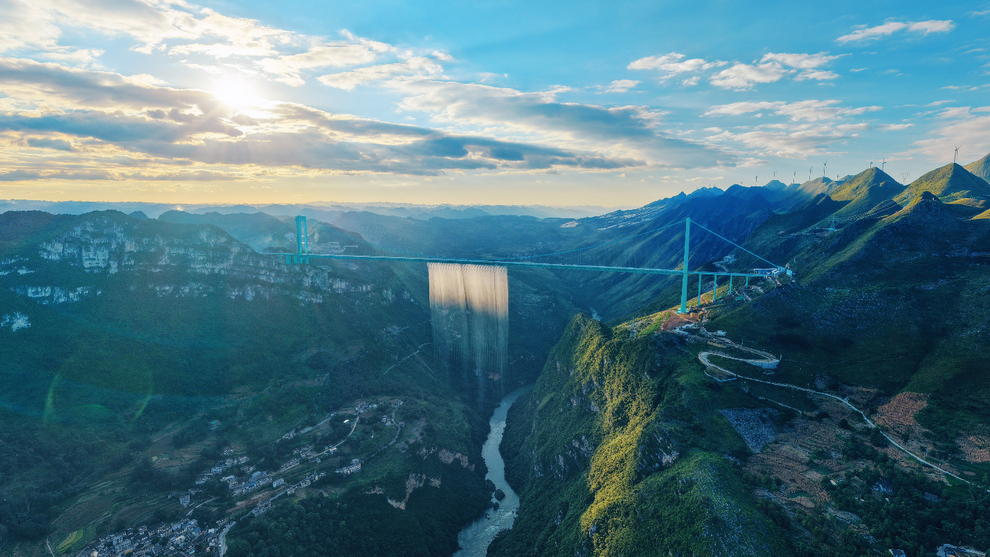The Huajiang Bridge in southwestern China's Guizhou Province officially opened to traffic on September 28.
The bridge is located at an altitude of about 800m above river level. This height is equivalent to 2 Eiffel Towers stacked on top of each other (the Eiffel Tower is about 325m high).

In addition to the cafe on the clouds, the bridge also has a glass observation room with an area of 1,000 square meters. The room has a vertical drop of more than 600 meters to the river below.
Besides, visitors can also try activities such as bungee jumping (an extreme sport in which the player is tied to a highly elastic rope and jumps down) and low-altitude skydiving.
This is China's first bridge-adventure tourism complex, making it one of the most unique destinations.
The bridge currently holds the world record for both height and length. With a main span of 1,420m, Hoa Giang Bridge has a height of 625m from the bridge deck to the river.
The 2,890m long project spans the Huajiang Gorge - known as the "crack in the Earth", and is a vital route on the Liuzhi - Anlong Expressway, helping to shorten the time to cross the gorge from 2 hours to just 2 minutes.
Right from the initial design, the project took into account the integration of tourism resources, creating a new model combining transportation and tourism. In addition to the transportation task, the project is expected to become a driving force to promote local tourism economy, bringing people's lives to a new level.

The project helps shorten travel time over the mountain from 2 hours to 2 minutes (Photo: CGTN).
During the construction process, a series of modern technologies were applied, from satellite support operations to the use of drones to precisely control construction at heights of hundreds of meters.
In just three years, the construction team achieved millimeter-level accuracy at an altitude of 600 meters. In particular, the smart cable system with integrated fiber optic sensors allows for continuous monitoring of stress, temperature and humidity, ensuring long-term sustainability.
Another highlight of the project is the use of local resources. Specifically, the construction team crushed dolomite into powder to replace a scarce material. This helped save about 5 million yuan (about 18.5 billion VND).
Earlier on the morning of September 28, thousands of local people, officials at all levels and tourists were present on the bridge to attend the inauguration ceremony, marking another miracle in the history of bridge construction in Guizhou and China.
Amid the festive atmosphere, Ms. Lu Cung, a woman of the Bo Y ethnic group, wore traditional costume to witness the historic moment of her homeland.
“I am very happy to see a historic bridge appear right in my hometown. The bridge makes traveling more convenient and will definitely attract more tourists to Guizhou,” she shared.
It is known that her family also runs a small restaurant at Van Do service station, specializing in serving specialties of the Bo Y ethnic group. The family expects to welcome a sharp increase in customers thanks to the bridge.
Mr. Luong Thieu Vu, former head of Hoa Giang village, now over 70 years old, emotionally recalled the time when people had to use bamboo rafts. Later, people used iron chain bridges to cross the river.
"Since I was 8 years old, I have witnessed how hard life is for the people. Now, the new bridge has brought with it opportunities. Tourists from all over the country come, so many old houses in the village have been converted into homestays to serve tourists," he said.
According to the Chinese Ministry of Transport, during the 14th Five-Year Plan period (2021-2025), China continues to invest heavily in infrastructure. The country currently owns the world's largest expressway network, with a total length of 191,000km, covering 99% of cities with a population of over 200,000.
Source: https://dantri.com.vn/du-lich/quan-ca-phe-o-cau-cao-nhat-the-gioi-vuot-hem-nui-tu-2-tieng-xuong-2-phut-20250929154831788.htm


![[Photo] Many streets in Hanoi were flooded due to the effects of storm Bualoi](https://vphoto.vietnam.vn/thumb/1200x675/vietnam/resource/IMAGE/2025/9/29/18b658aa0fa2495c927ade4bbe0096df)
![[Photo] General Secretary To Lam attends the ceremony to celebrate the 80th anniversary of the post and telecommunications sector and the 66th anniversary of the science and technology sector.](https://vphoto.vietnam.vn/thumb/1200x675/vietnam/resource/IMAGE/2025/9/29/8e86b39b8fe44121a2b14a031f4cef46)
![[Photo] General Secretary To Lam chairs the meeting of the Central Steering Committee on preventing and combating corruption, waste and negativity](https://vphoto.vietnam.vn/thumb/1200x675/vietnam/resource/IMAGE/2025/9/29/fb2a8712315d4213a16322588c57b975)

![[Photo] General Secretary To Lam receives US Ambassador to Vietnam Marc Knapper](https://vphoto.vietnam.vn/thumb/1200x675/vietnam/resource/IMAGE/2025/9/29/c8fd0761aa184da7814aee57d87c49b3)
![[Photo] National Assembly Chairman Tran Thanh Man chairs the 8th Conference of full-time National Assembly deputies](https://vphoto.vietnam.vn/thumb/1200x675/vietnam/resource/IMAGE/2025/9/29/2c21459bc38d44ffaacd679ab9a0477c)


























































































Comment (0)